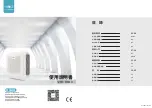
WARNING
Always check the gas density
limit for the room in which the
unit is installed.
1-10. Check of Limit Density
When installing an air conditioner in a room, it is necessary to
ensure that even if the refrigerant gas accidentally leaks out, its
density does not exceed the limit level for that room.
If the density could exceed the limit level, it is necessary to provide
an opening between the unit and the adjacent room, or to install
mechanical ventilation which is interlocked with a leak detector.
(Total refrigerant charged amount: oz)
(Min. indoor volume where the indoor unit is installed: ft.
3
)
<
Limit density 0.3 (oz/ft.
3
)
The limit density of refrigerant R410A which is used in this unit is
0.3 oz/ft.
3
(ISO 5149).
The shipped outdoor unit comes charged with the amount of refrig-
erant fixed for each type, so add it to the amount that is charged in
the field. (For the refrigerant charge amount at shipment, refer to the
unit’s nameplate.)
Minimum indoor volume & floor area as against the amount
of refrigerant is roughly as given in the following table.
0
0
57
114
170
227
2
8
4
3
41
3
9
8
454
511
56
8
625
6
8
2
7
38
795
8
52
909
966
1022
1079
11
3
6
0
500
1000
1500
2000
2500
3
000
3
500
4000
4500
5000
5500
6000
6500
7000
7500
8
000
8
500
9000
9500
10000
1000
500
1500 2000 2500
3
000
Total amo
un
t of refri
g
era
n
t
Mi
n
. i
n
door v
o
l
u
me
Mi
n
. i
n
door floor area
(whe
n
the ceili
ng
i
s
8
.
8
ft.
hi
g
h)
ft.
3
ft.
2
oz
Ra
ng
e above
the de
ns
ity limit of
0.
3
oz/ft.
3
(co
un
termea
su
re
s
n
eeded)
Ra
ng
e below
the de
ns
ity limit of
0.
3
oz/ft.
3
(co
un
termea
su
re
s
n
ot
n
eeded)
15 to 30
°
B
A
B
A
Tube branching
methods
(horizontal use)
Arrow view
Horizontal
line
View as seen
from arrow
Ball valve
(BV: p
u
rcha
s
ed
s
eparately)
Mai
n
t
u
bi
ng
Type
s
of vertical trap
s
pecificatio
ns
(If o
n
ly 1
un
it i
s
co
nn
ected, a ball valve
i
s
al
s
o
n
eeded o
n
thi
s
s
ide.)
I
n
door
un
it (1)
(When not u
s
in
g
b
all valve)
(When u
s
in
g
b
all valve)
Bra
n
ch t
u
bi
ng
i
s
directed
u
pward.
(Each
un
it i
s
co
nn
ected
to t
u
bi
ng
that i
s
either
level or i
s
directed
dow
n
ward.)
Mai
n
t
u
bi
ng
I
n
door
un
it
More tha
n
8
i
n
ch
I
n
door
un
it (more tha
n
2
un
it
s
)
Horizo
n
tal
I
n
door
un
it i
s
directed dow
n
ward
CAUTION
Pay special attention to any location,
such as a basement, etc., where leak-
ing refrigerant can accumulate, since
refrigerant gas is heavier than air.
1-11. Installing Distribution Joint
(1) Refer to “HOW TO ATTACH DISTRIBUTION JOINT” enclosed
with the optional distribution joint kit
(APR-CHP680BA, APR-CHP1350BA, APR-P160BA,
APR-P680BA, APR-P1350BA).
(2) When creating a branch using a commercially available
T-joint (header joint system), orient the main tubing so that it is
either horizontal (level) or vertical. In order to prevent accumu-
lation of refrigerant oil in stopped units, if the main tubing is
horizontal then each branch tubing length should be at an
angle that is greater than horizontal. If the main tubing is verti-
cal, provide a raised starting portion for each branch.
(3) If there are height differences between indoor units or if branch
tubing that follows a distribution joint is connected to only 1
unit, a trap or ball valve must be added to that
distribution joint. (When adding the ball valve, locate it
within 1.3 ft. of the distribution joint.)
If a trap or ball valve is not added, do not operate the sys-
tem before repairs to a malfunctioning unit are
completed. (The refrigerant oil sent through the tubing to
the malfunctioning unit will accumulate and may damage
the compressor.)
14
07-007 W-2WAY_II_NA 1/23/07 6:09 PM Page 14















































